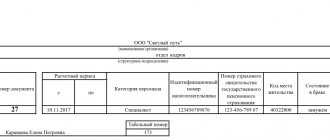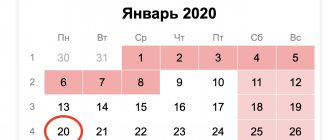What kind of report card is this?
A timesheet (hereinafter referred to as the timesheet) is a document with a list of employees of a department, service or other structural unit, in which notes are made on the use of working time during the accounting period.
According to Art. 84.1 of the Tax Code of the Russian Federation, when submitting a corresponding request, it is issued to the employee upon dismissal along with the work book. The functions of the time sheet as a primary accounting document are as follows:
- accounting for time worked or unworked by an employee;
- monitoring compliance with the established work schedule (timely attendance and departure from work, tardiness, early departures, adherence to lunch breaks, etc.);
- collection of official information about the time worked by each employee for calculating wages or compiling statistical reporting on labor for statistical authorities.
Thanks to the report card, the accountant will be able to confirm the correctness of calculations of wages and compensation for each employee, and the personnel officer will be able to track attendance and, if necessary, justify fines imposed on personnel.
Each timesheet is based on the company's shift or work schedule. It contains the following data:
- length of daily work or shift;
- start and end times of the working day;
- number of shifts per day;
- alternating working and non-working days.
It should be taken into account that the schedule is formed in such a way that the number of working hours corresponds to the established standards of daily and weekly working hours:
- the duration of working hours cannot exceed 40 hours per week, and for some categories of workers this figure cannot be more than 36 or 35 hours per week (Articles 91, 92 of the Labor Code of the Russian Federation);
- during a working day or shift, the employee must be given a break for rest and lunch, the duration of which cannot be less than 30 minutes, but no more than 2 hours, and this time is not counted as working time (Article 108 of the Labor Code of the Russian Federation);
- weekly uninterrupted rest cannot be less than 42 hours (in some weeks, when recording working hours in aggregate, the duration of weekly uninterrupted rest may decrease, but on average for the accounting period the norm must be observed; Articles 110, 104 of the Labor Code of the Russian Federation).
The employee must be included in the time sheet after being hired on the basis of the relevant order or employment contract.
After the dismissal order, he must be removed from the list of names. As a rule, the personnel number of a dismissed employee remains free for several years. The report card must be stored for 5 years, however, if working conditions are difficult, harmful and dangerous, then this period must be increased to 75 years.
Daily and summarized working time recording
To record working time, the accountant has the right to choose one of the methods depending on the characteristics of the organization of work at the enterprise: daily or summarized recording of working time. The first method is suitable for small organizations with a normal work schedule: a 5-day week with an 8-hour working day.
Keeping summarized records of working time is considered more labor-intensive. It is used when it is difficult to comply with the daily, weekly, monthly working hours corresponding to the normal working hours according to the production calendar (Article 100 of the Labor Code of the Russian Federation). When implementing summarized working time recording in an organization, registration of attendance/absenteeism in the working time sheet is carried out using a continuous method.
With summarized accounting, the indicators of actual time worked per month/week/day, as a rule, differ from the norms established by the production calendar. The employer is obliged to establish an accounting period: month, quarter, half-year or year, at the end of which the actual time worked must coincide with the standard working time according to the production calendar. Overtime during some time periods of the accounting period must be compensated for by shortcomings during other time periods.
Example. Security guard, working hours: every other day. For this employee, a summarized recording of working time with an accounting period of a quarter is used. In January, due to the security guard working shifts on holidays and weekends, the actual time worked exceeded the production calendar norm. In February the figures coincided. In March, the HR specialist must draw up a work schedule for this employee in such a way that, at the end of the quarter, the actual time worked coincides with the norm according to the production calendar.
Who keeps the timesheet?
The Instructions for the use and completion of forms of primary accounting documents note that the time sheet must be drawn up and maintained by an authorized person.
It must be signed by the head of the department and the HR employee. Only such a document can be transferred to the accounting department. Thus, the rules do not define the position of a specific person who should be responsible for maintaining the document, so the manager can assign any employee to perform this work. To do this, he must necessarily issue a corresponding order indicating the position and name of the responsible person. If there is no such order, then the obligation to maintain a time sheet must be specified in the employment contract, otherwise the employee may refuse to perform this work.
As a rule, large companies have special personnel whose responsibilities also include recording working hours. He fills out the form over the course of a month, submits it to his boss for signature, who checks it and puts his signature, and then passes it on to the accounting department. In small organizations, the time sheet is often kept by a personnel employee, who passes it on to the accountant.
Nuances of using the document
The Tax Code contains information that every person officially working in a company can, upon dismissal, request a report card together with other documents, which include a work book. This information is indicated in Art. 84.1 NK.
Since 2013, enterprise managers may not use unified forms when maintaining employee time sheets, since they have been abolished. But usually enterprise specialists use these documents. An example of maintaining a time sheet is located below.
It is allowed for specialists from the accounting department or human resources department to independently make various changes to this document. They depend on the specifics of the entire enterprise and the available number of employees on staff.
The form introduced by Goskomstat is considered convenient, so it can be easily processed and modified. Often it is used without any changes.
Forms of report cards and their differences
Working hours must be recorded regardless of the organizational and legal form and size of the staff, as stated in Part 4 of Art. 91 of the Labor Code of the Russian Federation.
For this, the following forms can be used - No. T-12 and No. T-13.
They were approved by Resolution of the State Statistics Committee of the Russian Federation 01/05/2004 No. 1 “On approval of unified forms of primary accounting documentation for recording labor and its payment.” The forms have the same purpose, but have the following differences:
1. Form No. T-13 is primarily used for recording working hours in an automated mode, therefore it is used in companies and institutions where a special turnstile is installed - an automatic system that controls the attendance of workers.
sample form No. T-13 archived in .xls format (Microsoft Excel) 2. Form No. T-12 is primarily used for recording working hours on paper and is considered a universal document.
sample form No. T-12 in the archive in .doc format (Word) 3. In form No. T-12, there is “Section 2” with columns for data on wages, which is not present in form No. T-13;
If the company maintains settlements with personnel as a separate type of accounting, then the second section of form No. T-12 can be left blank.
If necessary, changes can be made to the unified forms, but this will require initially issuing an appropriate order. It should be taken into account that you can only add columns to the document, but you cannot delete them.
Timesheet forms No. T-12 and No. T-13 are optional for use from January 1, 2013, so individual entrepreneurs and organizations can use other methods of monitoring the time employees spend at the workplace. In fact, the forms developed by Goskomstat are quite convenient and are still used everywhere.
Results
The Labor Code of the Russian Federation requires all employers to keep records of indicators reflecting employees’ attendance at work and the number of their working hours. For these purposes, a time sheet is used. The employer can conduct it manually or through automated solutions. In the first case, the T-12 form is used, in the second - the T-13 form. The exact form that HR officers need to use is specified in the local regulations.
You can learn more about the use of documents related to personnel records in an organization in the articles:
- “How to calculate the working time balance for 2017?”;
- .
You can find more complete information on the topic in ConsultantPlus. Full and free access to the system for 2 days.
Designations and codes in the table
When filling out a timesheet in form No. T-12 or No. T-13, 36 abbreviations are used, which reflect a wide variety of situations - from normal work to its suspension due to non-payment of wages to employees.
The amount of money that the staff will receive at the end of the accounting period depends on the codes indicated in the table, so you need to take it with full responsibility when filling it out. All standard abbreviations that can be used in the report card are presented in the following table:
| Code | Decoding | |
| alphabetic | digital | |
| 01 | I | Duration of work shift during the day |
| 02 | N | Length of work shift at night |
| 03 | RV | Duration of work on weekends/non-working days/holidays |
| 04 | WITH | Duration of overtime work |
| 05 | VM | Duration of work on a rotational basis |
| 06 | TO | Business trip time |
| 07 | PC | Period of advanced training without work |
| 08 | PM | A period of advanced training with a break from work in another area |
| 09 | FROM | Paid leave granted to an employee annually |
| 10 | OD | Additional paid leave that can be provided to an employee annually |
| 11 | U | Additional leave, which is given to an employee in connection with training, and assumes the preservation of average earnings, since the employee combines work and study |
| 12 | UV | Shortened work shift duration for on-the-job trainees with partial salary cuts |
| 13 | UD | Additional study leave without pay |
| 14 | R | Leave due to pregnancy / childbirth / adoption of an infant |
| 15 | coolant | Leave to care for a child until he reaches 3 years of age |
| 16 | BEFORE | Leave without pay, which is granted to the employee with the approval of the boss |
| 17 | OZ | Leave without pay in cases provided for by law |
| 18 | DB | Additional leave granted to an employee without pay |
| 19 | B | Temporary disability (sick leave) with payment of benefits |
| 20 | T | Temporary disability without benefits in cases provided for by law |
| 21 | Champions League | Shortened working hours in cases provided for by law |
| 22 | PV | A period of forced absence due to dismissal / transfer to another job / suspension with reinstatement to the previous place of work |
| 23 | G | Time off due to the performance of state/public duties in accordance with the law |
| 24 | ETC | Absenteeism – absence from work without a good reason |
| 25 | NS | Part-time work at the initiative of the employer in cases provided for by law |
| 26 | IN | Weekends (weekly vacation) and non-working days due to holidays |
| 27 | OB | Additional days off with pay (paid) |
| 28 | NV | Additional days off without pay (unpaid) |
| 29 | ZB | A strike that is carried out in accordance with the procedure established by law |
| 30 | NN | Absence from work for unknown reasons (until the circumstances are clarified) |
| 31 | RP | Downtime due to employer |
| 32 | NP | A period of downtime due to reasons that do not depend on either the employer or the employees |
| 33 | VP | Downtime due to employee |
| 34 | BUT | Suspension from work (preclusion from work) with payment (benefits) in accordance with the law |
| 35 | NB | Suspension from work for reasons provided by law, without pay |
| 36 | NZ | Suspension of work due to delays in payment of wages |
It should be noted that the second section of form No. T-12 contains columns for data on wages. Some codes may be included in them.
These include:
- 2000 – labor payments (salaries, rewards);
- 2010 – payments under civil contracts;
- 2012 – vacation pay;
- 2300 – sick leave benefit;
- 2530 – payment in kind;
- 2760 – financial assistance upon dismissal/retirement;
- 3020 – interest on deposits.
Filling rules
An employee of the enterprise who receives the authority to fill out this document must understand the nuances of the process of entering information. The rules for maintaining timesheets are considered simple and understandable. It is advisable to initially understand them well, which will allow you to work with the report conveniently and easily. The productivity of not only the HR department, but also the accounting department depends on this. Based on the correctly entered data, employees of the accounting department will be able to correctly calculate the wages of each employee of the enterprise.
The basic rules for filling out the document include the following:
- Initially, the correct form for maintaining time sheets is selected;
- the document is filled out in only one copy;
- It is allowed to manually enter data or use a computer for this purpose;
- the employee involved in this process must have the appropriate authority, for which the employer issues an order in advance;
- timesheets must be prepared at the beginning of a new month;
- information about the name of the company and existing divisions is entered on the title page;
- the accounting start date is indicated;
- at the end of the month, the end date for maintaining the report is indicated;
- the main sheet of the timesheet is represented by a table in which data about each employee of the organization is entered, and it is important to enter all names correctly in order to avoid confusion or errors;
- Reliable information must be available about each employee, and a number assigned to the specialist must be written down, which can be taken from the personal file;
- timesheet columns are represented by specific days of the month;
- opposite the names there are cells in which information about all hours or shifts worked is entered;
- if there are weekends or holidays, then this information must be indicated with special marks;
- information by the responsible person must be entered daily, for which the specialist is guided by official documents, which include various orders, statements, sick leave or orders of the company’s management;
- If lateness or absenteeism is recorded, they are assigned special codes consisting of numbers and letters.
The document is sealed with the signature of the head of the enterprise. Without this signature it will not be considered valid. The procedure for maintaining timesheets is considered simple, so every HR employee can cope with this process. If errors or irregularities are identified, it is the designated specialist who is responsible for this information.
Instructions for filling
The timesheet in question can be filled out in one of two ways:
- continuous - every day attendance, absence, number of working hours, etc. are entered;
- for deviations - data is entered only in cases where an employee is late, does not show up for work, etc.
Information about the reasons for absences, overtime, or incomplete work of a shift can be entered into the timesheet on the basis of third-party documents - sick leave, written consent to overtime, certificate of completion of public works, etc.
The first method is used much more often, since many companies fill out time sheets automatically every day, using form No. T-13 and computer programs that are part of the infrastructure of personnel access control systems to the enterprise. In small organizations, they will still fill out form No. T-12 using a regular ballpoint pen or PC programs like Word.
In any case, the principle of filling out the timesheet is the same. We will consider each step separately.
Step 1. Title page
The first page of the report card is filled out in the following order:
1. In the top field, enter the full name of the company or the full name of an individual entrepreneur (IP). If the organization is large and several timesheets are maintained, you will also need to indicate the name of the department (structural unit) - sales department, marketing department, production department, etc.
2. The next column indicates the OKPO code, which is an all-Russian indicator of enterprises and organizations. It is contained in Rosstat databases. Consists of 8 digits for legal entities and 10 digits for individual entrepreneurs.
3. The first plate of two cells indicates the document number (determined in order) and the date of its preparation (as a rule, the last day of the reporting month is entered). 4. The title page is completed by indicating the reporting period. The time sheet is made for a month, so the reporting period lasts from the first to the last day of the month.
Step 2. Employee information
The main table begins to fill.
In it, each employee is given a separate line. The first three cells contain the following data: 1. Number of the employee in order.
2. Last name and initials of the employee, as well as his position:
3. Personnel number, which is assigned to each employee for the entire period of work in the company and is used in all internal documentation (as a rule, it is transferred to another employee only a few years after the dismissal of the employee who previously worked):
Step 3. Data on attendance, no-show, number of hours
The entry is made in two lines:
- the first indicates attendance/non-appearance;
- the second indicates the number of hours.
Each column is assigned a specific number, and to record data on employee attendance/absence, conventional abbreviations are used, for example:
- I am turnout;
- On a weekend;
- K – business trip;
- From – vacation.
As a rule, few such symbols are used. As a rule, absences are classified according to the presence/absence of a valid reason. Different types of vacations, sick leave, etc. may be indicated.
Step 4. Total number of hours and days for the month
These data are given for half a month and for a month:
1. In the fifth column, enter the number of working days and hours for each half month:
2. In the sixth column the same data is entered, but for a month:
Step 5. Payroll data
To indicate information that affects the calculation of wages, several columns are given:
1. The seventh column indicates the type of payment, which is also encrypted with a symbol and determines the type of cash payment (code “2000” is the standard salary, and “2012” is vacation pay) :
2. The following column contains the corresponding account - the accounting account from which funds are written off to make the specified type of payment (the account for writing off salaries, vacation pay, travel allowances and other payments can be single):
3. The ninth column contains the number of days or hours worked for each type of remuneration (in the top cell you can indicate days of attendance and business trips, and in the bottom cell - vacation pay and sick leave):
4. If during the month one type of remuneration (salary) was applied to all employees, then its code and account number can be entered at the top, and columns 7 and 8 can be left empty, indicating only the days or hours worked in column 9:
Step 6. Information about the reasons and time of no-show
The next few fields are reserved for indicating the reasons why the employee was not present at the workplace. For this purpose, conventions are again used. The reason may be vacation, business trip, etc. The number of days or hours is entered in a separate column. For example, an employee could be absent for 3 days due to a business trip, and 10 days due to vacation:
Step 7. Signatures
At the end of the month, responsible persons put their signatures next to the corresponding position. Must sign:
- the employee who keeps the time sheet;
- head of a structural unit;
- HR worker.
sample timesheet archived in .xls format (Microsoft Excel)
How to Journal
The journal can be kept in electronic and paper form.
Electronic journaling is possible in different formats, depending on what software the employer uses. There are budget forms, in which almost all actions are carried out manually, and there are more complex, “advanced”, fully automated systems that transfer information directly to accounting programs (usually access to such software occurs only if the employee has a key).
In any case, the electronic form of the document is convenient, because allows you to save time, effort and makes it possible to easily control the working time of employees based on indicators such as unauthorized absences, overtime, sick leave, etc.
If the journal is kept in paper form, then all its sheets must be numbered, fastened together using a “harsh” thread (a stapler cannot be used), then the number of sheets must be marked on the last page, stamped (provided that the seal is used in the work of the organization) and sign the employee responsible for maintaining the journal. In the future, you should autograph each completed page of the document.
The journal is usually kept by a human resources specialist or an accounting employee. Depending on this, the storage location of the document during its validity period is determined.
The responsible employee is responsible not only for the accuracy of the information entered in the journal, but also for its timely and complete transfer to specialists for payroll, as well as for performing all other necessary actions.
Selected cases of tabulation
When filling out a timesheet, it is necessary to correctly display data on night hours, time off, absenteeism, vacations, and even dismissal. In order not to get confused with a large amount of information, we will consider each case separately.
Night hours
In Art. 96 of the Labor Code of the Russian Federation states that night work is the period from 22:00 to 06:00 local time. It can be of two types:
- ordinary (the employee is scheduled to go on the night shift or works according to the “every three days” scheme);
- overtime.
In the first case, the code “N” or “02” is indicated in the timesheet, and in the second, it is indicated through a fraction that the work was overtime (a separate line can be used for this purpose).
The timesheet rules prohibit excluding required fields, but allow you to enter additional items.
Time off
In modern labor legislation there is no such concept as “time off”.
It was inherited from Soviet times and was used in the Labor Code, which was in force with changes until 2002. In the current Labor Code of the Russian Federation, other terms are used - additional rest time, another day of rest, etc. So, in fact, time off is preserved, but different wording is used to designate it. Time off is granted in different cases:
- when donating blood;
- when working overtime, etc.
- to compensate an employee for performing work duties on weekends or other non-working days (instead of an additional day off, the employer may offer the employee increased pay);
Time off is not provided to those who work under a fixed-term contract lasting less than 2 months, so they can only qualify for increased pay.
So, in the time sheet, time off can be indicated under different codes:
- work on weekends/non-working days/holidays – “РВ”, “03”;
- forced time off upon reinstatement at the previous place of work - “PV”, “22”;
- paid time off – “OV”, “27”;
- unpaid time off – “NV”, “28”.
Absenteeism
This is the time when the employee was not at work. Depending on the reason for absence, the code to be entered into the timesheet is determined:
- absenteeism without a good reason - “PR”, “24”;
- absenteeism for unknown reasons – “NN”, “30”.
It should be borne in mind that the second code is used temporarily - until the circumstances of absenteeism are clarified. If the reason is subsequently recognized as valid, then a corrective report card is drawn up indicating a different code.
Absenteeism may not last the entire working day, but several hours.
In this case, it is reflected in the timesheet using a special method: in the corresponding cell, two codes are indicated through a fraction - absence and actual work. The fact is that the employee must receive payment for the hours worked, even if he was absent from work for more than 4 hours, for which he can be fired in accordance with paragraph “a” of Part 6 of Art. 81 Labor Code of the Russian Federation. Finally, you should pay attention to the typical mistake that many timekeepers make when marking with an absenteeism code the time when the employee was absent from work due to administrative detention or being in custody. This happens against his will, therefore it is not considered absenteeism without a good reason, although it is not paid by virtue of Art. 129 Labor Code of the Russian Federation. In this case, the most acceptable code is “NN” or “30”.
Vacation
There are different codes for designating leave, the choice of which depends on the type of leave and its duration. Here are all the possible options:
- annual paid leave – “FROM”, “09”;
- annual additional paid leave – “OD”, “10”;
- leave for an employee who combines work and study - “U”, “11”;
- leave for a student without pay – “UD”, “13”;
- maternity leave, pregnancy leave, adoption of a newborn - “P”, “14”;
- leave to care for a child up to 3 years old – “OZH”, “15”;
- leave at your own expense with the permission of the employer - “DO”, “16”;
- leave without pay, granted in cases provided for by law - “OZ”, “17”;
- daily additional leave without pay – “DB”, “18”.
If the time sheet is filled out using the continuous method, the vacation symbol is indicated for each day the employee is absent, and if using the deviation method, the cells are left empty. In this case, not only working days are filled, but also weekends falling during the vacation period, since vacation pay is accrued for calendar days. However, holidays and non-working days that fall during the vacation period must be underlined or left blank.
Business trip
During a business trip, an employee receives payment for all working days according to the company’s schedule, so during this period, working hours should be displayed in this way:
- in the top line, enter the number of hours worked according to the company’s work schedule (for example, 8 hours), regardless of how many hours the employee actually worked at the place of business trip;
- in the bottom line indicate the designation of the business trip (business trip - “K”, “06”).
If the day of the business trip falls on a weekend, then you can put a dash in the top cell, and the corresponding code in the bottom. If the employee was specially sent on a business trip on his day off, then in the top line you need to indicate the number of hours he worked, and in the bottom line, separated by a fraction, the codes “РВ”/“К” or “03”/“06” (hours on weekends and holidays) days / business trip).
Dismissal
HR officers doubt whether it is worth celebrating the dismissal of an employee in the middle of the month and in the following days, when he is no longer on the payroll.
There are no notes on this matter in the regulatory documents, but from the contents of the resolution of the State Statistics Committee of the Russian Federation No. 1 of 01/05/2004 it follows that the last working day of an employee can be designated by the appearance code “I” or “01”, but provided that it was fully worked . The days following dismissal do not need to be designated in any way - the employee has already been excluded from the company’s staff, so there is no need to keep records of his working time. Meanwhile, in order to eliminate the possibility of future forgeries or erasures, it is better to put dashes in empty cells.
How to fill out a timesheet when an employee does not show up for work
Before filling out the timesheet, you must print a report indicating the employee’s absence from the workplace. Its preparation requires the presence of several persons who can confirm this fact and act as witnesses. They must indicate personal information in the document.
It is important to take into account that the minimum number of witnesses is 3 people.
The employee’s manager draws up a note about the employee’s absence and, together with the report, transfers the documents to higher management for further resolution of the current situation. If there is no information about the reason for the employee’s failure to appear at work at the appointed time, the designation NN is affixed to the document. Next, the encoding changes: in the case of open sick leave B, if absenteeism - PR.
Features of keeping timesheets for state employees
In budgetary organizations, to record employee time, mandatory form No. 0504421 is used, which was approved by order of the Ministry of Finance of the Russian Federation dated March 30, 2015 No. 52n.
sample of a standard document form for archiving in .xls format (Microsoft Excel) Such a timesheet should always be kept in a single copy, opening 2-3 days before the start of the billing period. It is prohibited to make changes to the established form.
According to the letter of the Ministry of Finance of the Russian Federation dated June 2, 2016 N 02-06-10/32007, this document can also be filled out in two ways:
- continuous – all attendances and absences of employees are noted;
- by deviations - only deviations from the normal work schedule are recorded (vacation days, days off, etc.).
Both methods are equivalent, but in budgetary organizations the second one is more often used.
The procedure for filling out the document is the same as in the case of filling out forms No. T-12 or No. T-13. The report card in form No. 0504421 is mandatory for budgetary institutions, but can also be used by commercial organizations, which is especially important in the case of private kindergartens or schools.
Nuances of entering various information
Filling out this document is actually quite simple. To do this, you just need to understand the purpose of each cell. Responsible persons authorized to fill out documentation should carefully study the contents of the document. Features of the filling process include:
- it is allowed to increase the number of columns;
- codes for hours spent are reflected at the top, and at the bottom it is indicated how much was actually worked by the specialist on a particular day;
- Each employee of the organization must have a personal number in the timesheet, which is used to calculate salaries and perform other actions;
- Part-time workers are assigned two numbers;
- It is required to indicate both the days worked and the number of hours that were actually worked by the specialist each day;
- at the end of each month, the report card is submitted to the personnel service, and specialists from this department check the correctness of the document, and you should also make sure that the working hours missed by employees are not absenteeism;
- if any specialist resigns, then from the next month his number will not be used when filling out the timesheet;
- It is required to indicate data on absenteeism, days off, as well as time off, vacations, business trips or other reasons why a specialist is absent from the workplace.
If the length of the working day is indicated in hours, then there is no need to record partial hours.
Popular questions
When filling out a timesheet, a number of questions arise, the most popular of which are discussed below:
- Do I need to display a 1 hour reduction in working hours on a public holiday?
On the eve of holidays and non-working days, the working hours of full-time employees may be reduced by 1 hour. In this case, the work week can be either 5-day or 6-day. In any case, this reduction must be reflected in the time sheet, otherwise inspectors may insist that employees worked overtime on such days. - Why is there 2 cells for each day in the table?
It’s simple: the first cell indicates the symbol of the type of labor, and the second cell indicates the number of hours worked. The timekeeper may, at his discretion, use either an alphabetic or a numeric code. - How many times a month should I fill out a timesheet?
This must be done every day so that employee time recording is reliable. At the end of each month, the total number of hours worked by each employee is summed up. The time sheet signed by the responsible persons is transferred to the accounting department to calculate wages for the month worked. - Do I need to fill out a separate timesheet for the advance payment?
If the company provides for advances, to calculate their amount, the accountant must receive a timesheet for the first half of the month (from the 1st to the 15th inclusive). To do this, the HR department can give him the document on the 16th, and take it back on the 17th. There are other options: certify a copy of the advance payment slip, which will remain in the accounting department and will be filed for calculation; generate separate timesheets for the first and second half of the month, and then a consolidated one. The procedure for transferring the timesheet for advance payment must be recorded in the company’s internal documents. - Is it possible to make corrections to the timesheet?
In general, they are prohibited, but in some cases changes may be made to the document. For example, if an employee reported sick leave late or, while on vacation, got sick and brought sick leave after returning to work. All changes to the timesheet must be made on the basis of supporting documents received from the employee.
The report card in question is an act that contains information about each employee’s compliance with the work regime. To maintain it, you can use the forms recommended by the State Statistics Committee - No. T-12 or No. T-13. In any case, at the end of each reporting period, the completed document must be submitted to the accounting department to calculate salaries and various compensations provided for by the terms of the employment contract.
Responsibility for errors
If an audit comes to an organization, then first of all the following errors and inaccuracies are searched for:
- The information indicated in the timesheet does not correspond to the information recorded in the financial statements when calculating wages.
- The data recorded in the settlement documentation differs from the amount of the calculated salary.
- Lack of recording of overworked time, incorrectly used coding.
- The calculation of the amount of benefits in accordance with the sheet of temporary incapacity is displayed incorrectly.
If the above violations are detected, the tax authority may apply penalties to the enterprise in the form of an administrative penalty in the amount of 5,000 rubles. If the organization completely lacks a report card, the head of the company may be punished in the amount of 50,000 rubles on the basis of Article 5.27 of the Administrative Code.
A timesheet recording the time worked by an employee is a mandatory event. However, there is no set format that must be strictly followed. The company has the right to independently develop a scheme for its management.
Top
Write your question in the form below
How is it filled out when paying by piece?
Quite often, enterprises use piecework wages, which leads to difficulties when filling out time sheets. Instructions for maintaining time sheets for piece workers are as follows:
- remuneration depends on the volume of work performed by a specialist;
- the document must take into account the output for each employee of the enterprise;
- it is allowed to measure work in hours, for example, this is required in schools or other educational institutions, so the time of work should be indicated in the report card;
- in other situations, the code Y01 is used, so there is no need to fill out the last line of this documentation;
- Work on holidays is paid separately, and the amount of payment depends on the information contained in the collective agreement.
Thus, even if you have a piece-rate form of remuneration, filling out a timesheet is quite simple.











